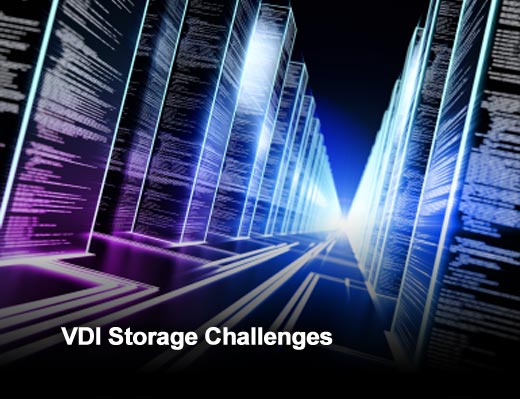There are a number of technical challenges to consider when it comes to virtual desktop infrastructure (VDI), from understanding associated licensing requirements to wide area network issues. Perhaps the single most difficult pain point when it comes to VDI, though, is storage.
This slideshow features common storage challenges for VDI projects, as identified by Geoff Stedman, vice president of marketing at Tintri. Learn what they are, and how you can possibly avoid some of these missteps.
Click through for the top six challenges to consider when implementing a VDI project, as identified by Geoff Stedman, vice president of marketing at Tintri.
As with any technology deployment, you first must assess what kind of ROI it will provide your business. If the VDI project is taking up a lot of your IT department’s time with little to no benefit, your project will undoubtedly fail.
With VDI projects, companies can often over-provision storage in an effort to meet performance requirements. This creates a higher capital cost than needed with companies buying hundreds of disks and installing more capacity than necessary, eventually leading to higher operational costs. Over-provisioning creates a large storage footprint, increasing management, space, and power and cooling expenses.
Find a solution that can easily illustrate how many virtual machines a given system can handle. Remember, high VM density can help change the economics of VDI storage. A pilot program is a great way to start out to see if your storage solution will fit your current and projected needs.
VDI produces small, random write-intensive IO in a steady state and bursts of IO during peak workloads for short periods. Legacy disk-based storage arrays do not perform well with this kind of random IO pattern. Adding flash as read-cache is not sufficient, as it typically cannot deliver consistent performance in this type of environment.
There are a lot of new flash vendors that have emerged on the market with flash-based storage to help ease the pain points in this area. Look for solutions that leverage flash as first-class storage for reads and writes. This will help with the latency that occurs during sporadic workloads to provide consistent performance.
As was referenced in slide one, it is important to have a project not over-consume your IT department’s resources. The faster you can deploy your storage infrastructure and the easier it is to manage your storage device, the better your eventual return.
With VDI, you continually have to manage more desktops as they come online. Be sure to find a storage solution that can easily be configured – think minutes, not days – and can easily monitor, troubleshoot and adapt to changing VDI workloads.
Most VDI projects start out as small virtual desktop installations and grow incrementally. Unfortunately, it is hard to predict your scalability needs, and there will likely be a certain trial and error period as you grow your infrastructure. So, if you are starting with an architecture designed for a 500-seat VDI pilot using legacy storage systems, these same architectures likely won’t work for a 5,000-seat production environment.
Many VDI initiatives have come to a standstill for this very reason. Look to storage solutions that can easily scale and can give you direct insight into how much performance resources are being consumed and how much are available at all times. Having a granular view into performance and consumption can help you plan and scale your VDI projects to meet future demands.
Architecting, provisioning and maintaining end-to-end solutions for large VDI environments can require many hours of administration. Best practices for VDI storage architectures using a traditional SAN or NAS solution means multiple datastores across multiple LUNs for storing base and replica images, OS disk, persistent disk and disposable disk on different storage tiers. This complexity makes the process error-prone.
Find solutions that can be easily provisioned and provide intelligent visibility into how VDI workloads are impacting storage resources. Careful orchestration ensures that storage resources will not become overrun.
A major consideration for VDI is data protection, especially for large-scale VDI projects with thousands of VMs. One common technique used for VDI data protection is snapshots, a storage system feature available on many storage systems.
Most traditional storage devices were designed for physical workloads and support volume-level snapshots, meaning that an entire volume snapshot is taken at one time. However, within a single volume there can be hundreds of VMs, resulting in inefficient storage utilization if more VMs are being snapshotted than actually need to be, and recovery procedures can be cumbersome if needed for only a single VM. New VM-aware storage can actually solve this problem by taking snapshots and enable cloning on a per-VM basis. Per-VM storage management allows for highly granular and more efficient data protection and recovery.









